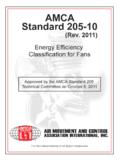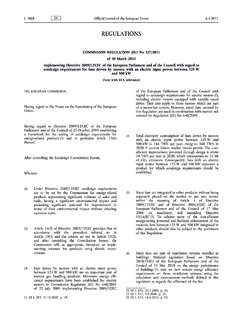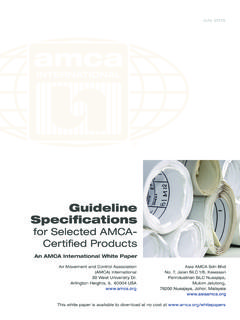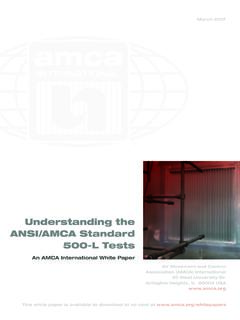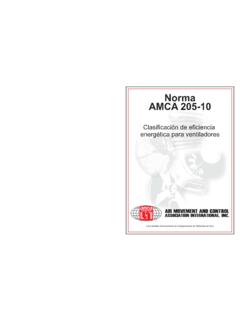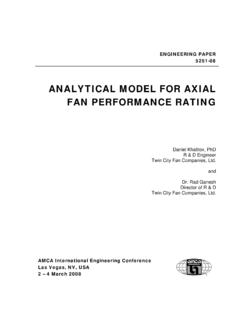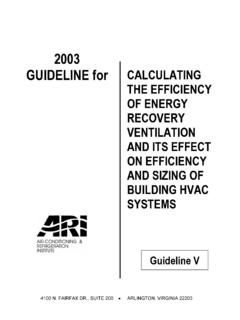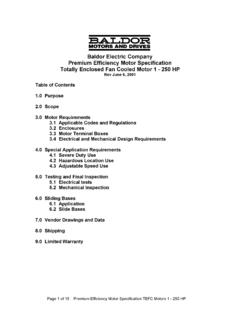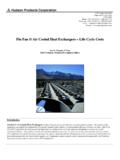Transcription of AMCA’s Fan Efficiency Grades
1 InternatIonal inmotionFall 20118 Learn what FEGs are and how they are applied for HVAC systems in commercial and industrial buildings. It has become clear that fan system design improvements and higher Efficiency fans could have substantially reduced HVAC energy use in commercial and industrial buildings. Until recent-ly, fan selection guidance and metrics that allow quick comparison of fan efficiencies have not been available. One ap-proach has been to specify a fan Efficiency rating based on the aerodynamic properties of the fan itself, and to specify where on the fan Efficiency curve the fan operation point should essence, this is what AMCA International, working with ASHRAE s TC fan committee, has done with the develop-ment of a new fan Efficiency classification system, called the Fan Efficiency Grade (FEG). Work that began in 2007 to address fan Efficiency classifications is now paying off.
2 FEGs were formalized with the publication of AMCA 205 in 2010, and an AMCA Certified Ratings Program is now in place to provide third-party verification of FEGs as spec-ified in AMCA 211. This article answers questions that engineers, building owners, operators, regulators, and contractors may have about is a Fan Efficiency Grade?A fan Efficiency grade (FEG) is a numerical rating that classi-fies fans by their aerodynamic ability to convert mechanical shaft power, or impeller power in the case of a direct driven fan, to air power. Essentially, it reflects fan energy Efficiency , allowing engineers to more easily differentiate between fan models: more efficient fan models will have higher FEG rat-ings. FEGs apply to the Efficiency of the fan only and not to the motor and drives. FEG ratings can be applied to custom-built single fans and to series-produced fans manufactured in large quantities. In 2007, the ASHRAE Standing Standard Project Committee (SSPC) s, mechanical subcommittee, invited ASHRAE TC , Fans, to participate in the development of the requirements for fan Efficiency .
3 An ad hoc working group was formed promptly. With assistance from the AMCA Fan Committee, the group first developed a system for energy- Efficiency classification of fans. The group recognized that a highly efficient fan will operate inefficiently if used in the low- Efficiency region of the fan curve. This led to a require-ment that fans be specified within 10 percentage points of the peak total Efficiency (Figure 1).FEGs were developed by AMCA in response to regulators in the and abroad taking interest in reducing fan energy consumption and the environ mental impacts of that consump-tion. Simultaneously, the International Standards Organization (ISO) was considering a similar Efficiency rating for European energy standards and regulations. For the market, where fans are normally cataloged as bare-shaft fans and purchased with standard NEMA motors, FEGs were defined through AMCA Standard 205-10, Energy Efficiency Classification for Fans.
4 AMCA Publication 211, By Tim maThson, principal engineer for centrifugal, vane axial, and industrial products, Greenheck Fan Corp., Schofield, Wis.; and michael ivanovich, director of strategic energy initiatives, AMCA International, Arlington Hts., s Fan Efficiency Grades : answers to Frequently asked QuestionsFigure 1: A typical fan curve showing the 10-point total Efficiency InternatIonal inmotionFall 20119 Product Rating Manual for Fan Air Performance, describes the certification process for rating a fan for the European Union, where fans are often packaged with integral motors, ISO Standard 12759-2010, Efficiency classifica-tion for fans, defines fan-motor Efficiency Grades (FMEG). Note that these two Grades are not equivalent and in no circumstances should FEG and FMEG be used simultaneously to evaluate fan are FEGs used for?FEG ratings are used by code authorities or by specifying engi-neers to define a minimum requirement for energy Efficiency of a fan for a given application.
5 The specifications can use a single-value FEG for each application. The use of a single number is possible because the shapes of the FEG bands closely follow the actual peak efficiencies for typical fan designs (Figure 2). Smaller fans are typically less efficient than larger fans for a given fan type, and this trend is reflected in the shape of the Efficiency bands. Rather than making individual fan selections to determine a minimum Efficiency target for each duty point, the specifying engineer can simply establish a mini-mum FEG for the application ( , FEG71 for all supply fans, FEG67 for all exhaust fans, etc.). Minimum FEGs can also be ad-opted by energy codes and standards, such as ANSI/ASHRAE/IES , Energy Standard for Buildings Except Low-Rise Residential Buildings, and the International Code Council s International Green Construction Code (IGCC).How are FEG ratings calculated?FEGs are based on peak total Efficiency for a given fan size.
6 The FEG is established by plotting the peak total Efficiency at the appropriate impeller diameter, then reading the associated FEG band in which this point falls. For example, a fan with an impeller diameter of 15 in. and a peak total Efficiency of 71% would have an FEG of 80 (Figure 3). Annex A to AMCA 205-10 provides equations for the upper and lower boundaries of each fan Efficiency grade, as well as a table of peak fan total Efficiency versus fan size that can be used to calculate the FEG. Engineers and other practitioners, however, will not have to calculate FEGs; they will find them in manufacturers literature and software as they become available. AMCA-certified FEG ratings for fans will be identified in search results from the AMCA certified product database at fan types and sizes are covered, and which ones are not?AMCA 205 and AMCA 211 have slight differences with respect to minimum fan sizes, and there are a few other differences as well, as shown in Table 1.
7 AMCA 205 is currently being revised, after which it will be harmonized with AMCA 211. When codes and standards set FEG requirements, they will specify FEG ratings, fan sizes, and exclusions. For example, ASHRAE is using FEG67 as its minimum FEG rating, and for fans above 5 hp; and there are a number of exclusions beyond those named in AMCA 211. Figure 3: FEG band area for FEG80. Peak total Efficiency , pTE (%)9080706050403020501015202530354045 FEG 80 FEG 85 FEG 75 FEG 71 FEG 67 FEG 63 FEG 60 FEG 56 FEG 53 FEG 50 Impeller Diameter (in)Figure 2: FEGs for various fan efficiencies and sizes. InternatIonal inmotionFall 201110 For a given duty (flow rate and pressure), several fan types and multiple fan sizes may be considered. When making fan selec-tions, the list of available fans is first checked to ensure they meet the minimum FEG requirement. This means they must meet the required peak total Efficiency but also must be se-lected within 10 percentage points of this peak.
8 After that, the refined list of fans is compared using first cost and operating cost, and any other parameters, such as sound, physical size, and so forth. The actual fan input power becomes the basis for the operating cost used in a payback, ROI, or other economic analysis that can be used to compare annual and lifecycle costs for different fan types and sizes:From Table 2, note that eight fans are physically capable of the performance required, and each of these fans happens to have the same FEG rating. The smallest three fans are not selected within 10 percentage points of the peak Efficiency . These fans would operate near the bottom of their fan pressure curves; therefore, they would not meet Standard 205 and would not be considered for this duty. The remaining fans sizes, which range The IGCC is considering FEG71 as a minimum threshold for fans at or above 1 hp. The IGCC, which is a reach code ad-opted by organizations looking for beyond code building energy performance, is scheduled to release Version 1 of the code in 2012.
9 The IGCC requirement is proposed for the pre-scriptive section of the code, which is applicable for buildings up to 25,000 sq ft. For the most up-to-date information on AMCA 205 revisions and matching to 211, visit do I consider FEG ratings in my projects when sizing, selecting, and specifying fans? What about fan systems, that is, fans with motors and drives?Once an engineer has narrowed the list of available fans to only those that meet the minimum FEG rating as specified, the focus should be on actual power consumed. Since FEG ratings are a measure of peak fan energy Efficiency and not actual operating Efficiency , their main value is in differentiating between different fan types. sTandardYearmin. sizemax. sizemin. annual energYexclusions*AMCA 2052010 1/6 hp (125 W)None1,000 kWhNone (this will change)AMCA 21120111 hp (750 W)NoneNoneAir curtains; induced flow fans; energy recovery ventilators (heat recovery ventilators); positive pressure ventilatorsTable 1: Differences in AMCA FEG standards 205-2010 and 211-2011.
10 *Exclusions are listed in the Certified Ratings Program in AMCA 211 because their primary purpose is not to move air, there is no standardized method to determine their fan total Efficiency , or their primary function is life safety. Fan size (in.)Fan speed (rpm)Fan classFan power (bhp)acTual sTaTic- eFFiciencYacTual ToTal eFFiciencYpeak ToTal eFFiciencYFeginleT * * * 2 presenTs an example oF Fan selecTions using Feg and peak ToTal Efficiency raTings. Table 2: Fan selection example using single-width, single-inlet (SWSI) fans with ducted outlet and 10,000 cfm at 3-in. Pt. *Total Efficiency for these selections is not within 10% of peak InternatIonal inmotionFall 201111 Size 33:Total mechanical power = fan shaft bhp + hp drive loss = hpTotal kW into motor = hp kW/hp/ motor Efficiency = kWTotal annual cost = kW 16 hours/day 365 days/year $ = $2,908 Annual Savings = $3,446 $2,908 = $538 What codes or standards refer to FEG ratings?
